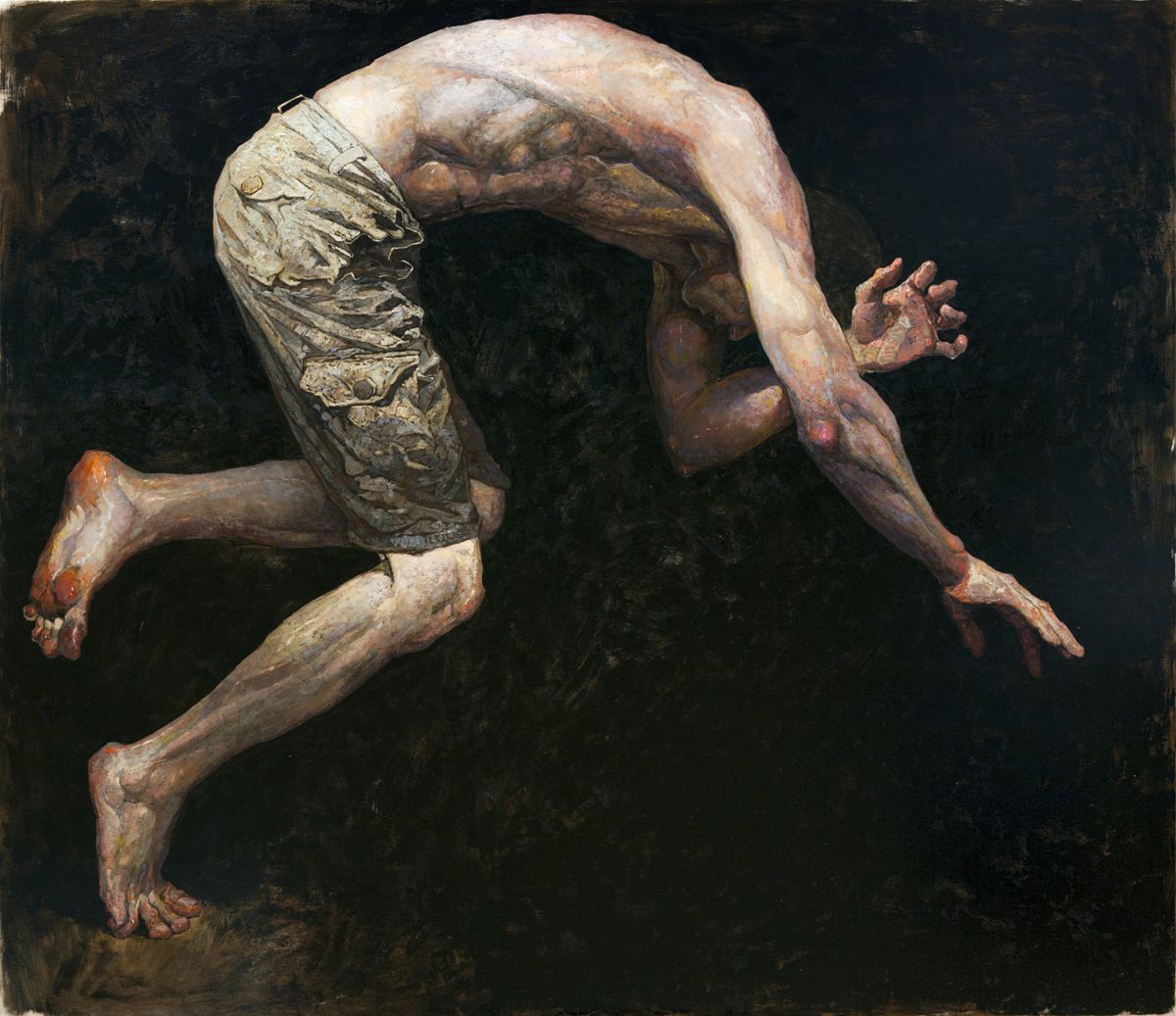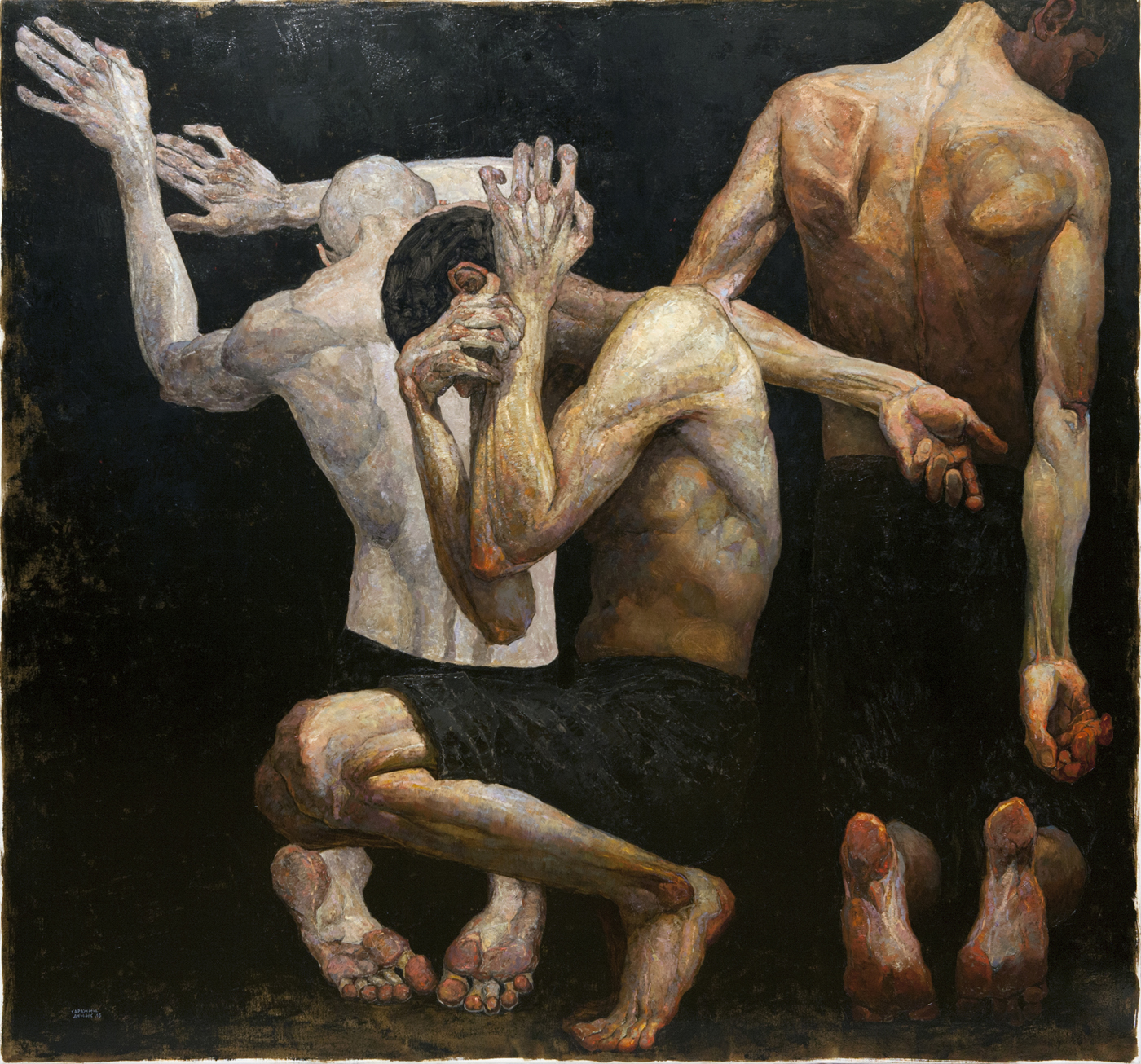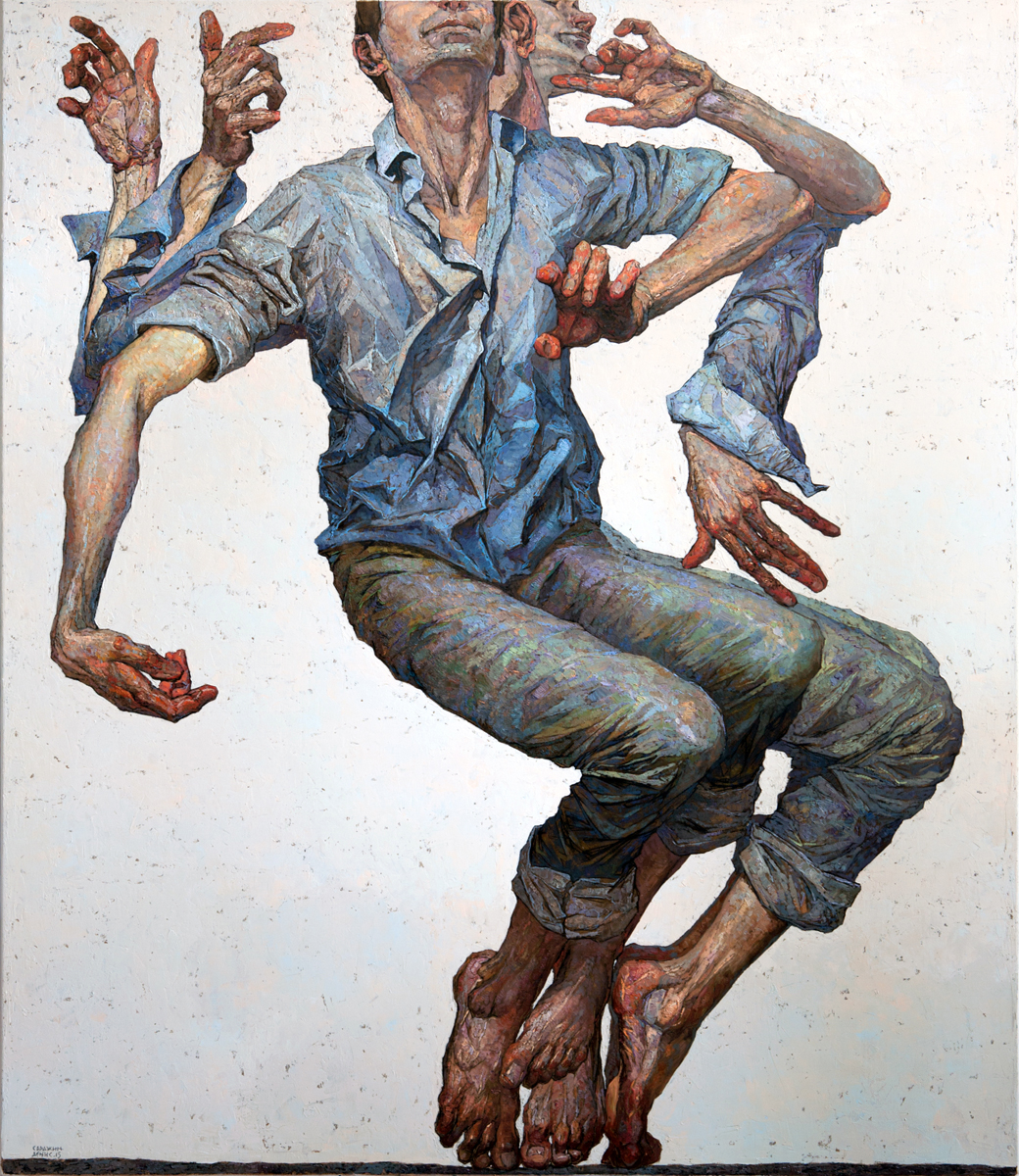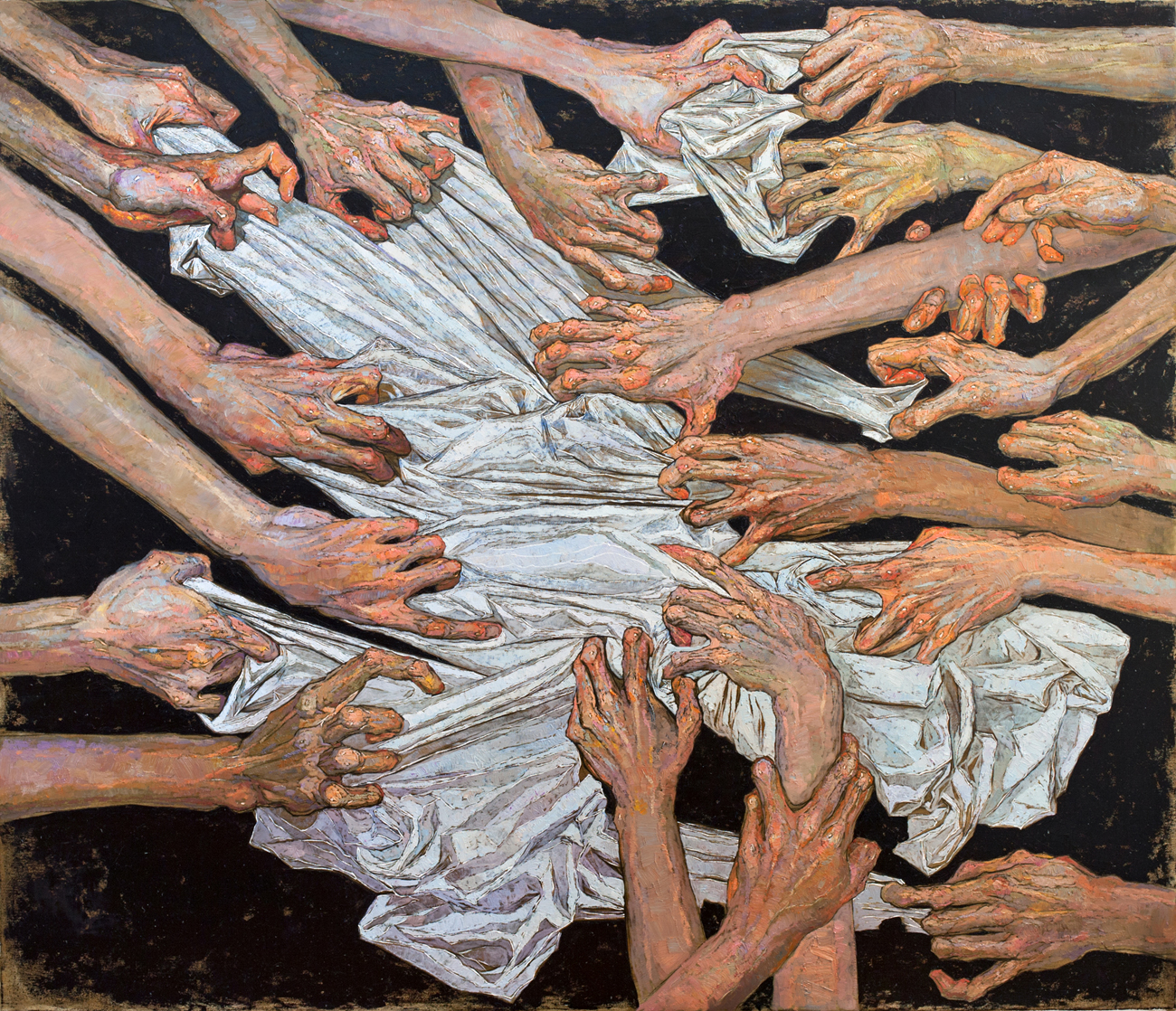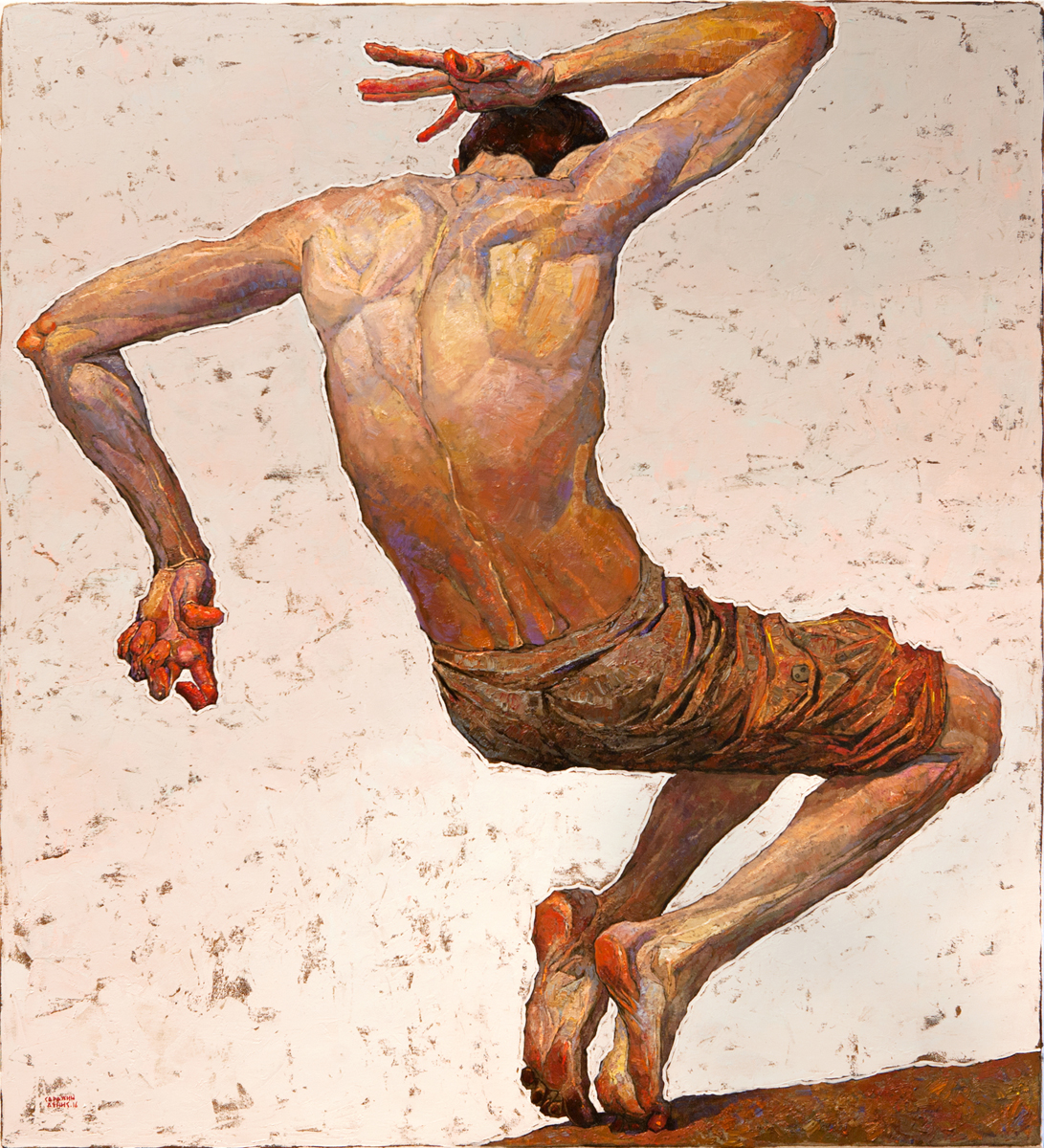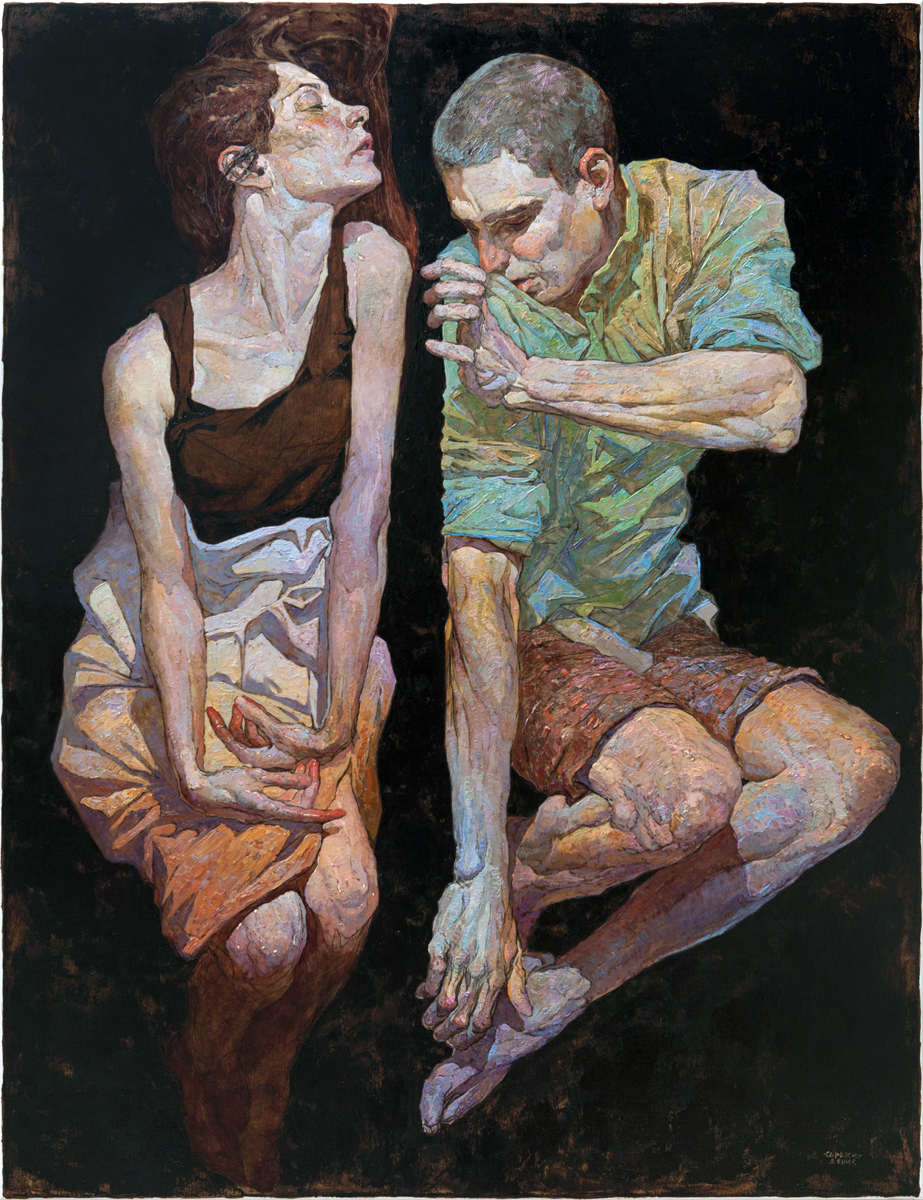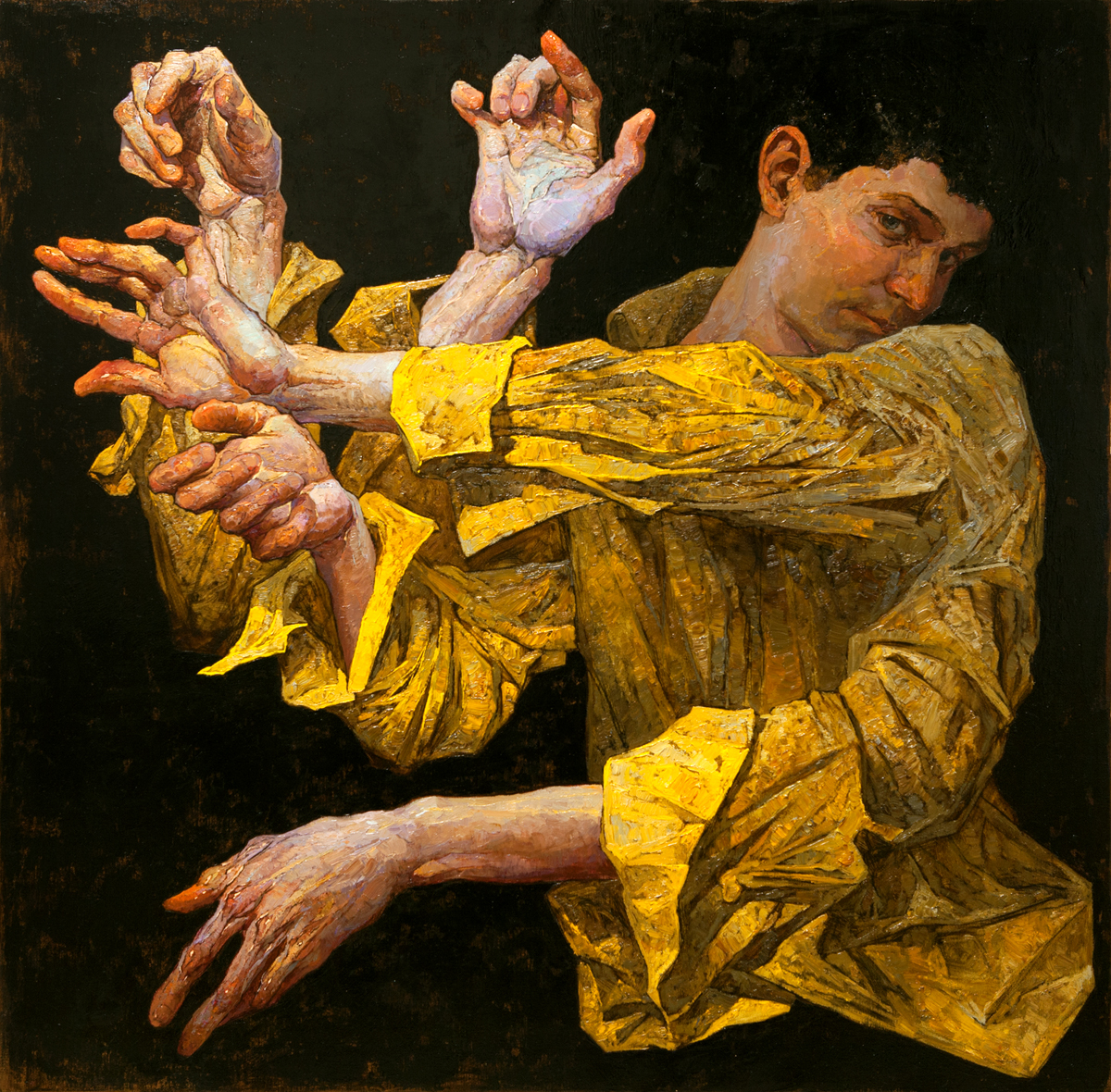The Figurative Communication of Denis Sarazhin
Pantomime 3 (2014). Oil on canvas.
Denis Sarazhin’s Pantomime Series (2014-) forecloses ‘language’ in returning to the painterly and figural. He focusses our attention on the body by cleverly frustrating the viewer’s instinctive glance toward the subject’s face. In this way, the artist challenges us to reconsider the communicative potential of the body. Compellingly painted, they reward contemplation. Sarazhin’s ‘return to the body’ without reference to the ‘face’ is an important contribution to the post-language debates that reverberate inside and outside the gallery.
Sarazhin’s Pantomime Series successfully intervenes in contemporary aesthetics and philosophy. He’s first and foremost a painter—a very talented one—trained in the old school of Soviet Realism at the Kharkov Academy and therefore uniquely positioned to succeed in the post-postmodern scene. In postmodernism, the concept was valorised while the figure was denigrated and pop-culture abused the haughtiness of high-modernism. Its post-structuralist impulse also preferred ‘word-play’ over the painted image. However, it’s now recognised that such ‘word’ and ‘concept-play’ is just as elitist as high-modernism. It’s now safe for the painterly and figural image to return. Sarazhin’s at the forefront of this exciting post-postmodern moment. He nonetheless appreciates post-structuralism and postmodernism’s salient criticisms of the autonomous and unitary subject. He’s not naïve. He doesn’t simply ‘return’ to the painterly and figural without recognising what’s gone before. Instead, he disowns postmodernism’s ‘conceptualism’ by focussing on the body’s communicative potential rather than that of language previously emphasised by post-structuralism; but he doesn’t disown post-structuralism and postmodernism’s critiques of the subject because the viewer is always denied a clear glimpse of the subject’s face. If, as Louis Althusser avers in Cremonini, Painter of the Abstract,[1] the human face is the ‘seat of the subject’, then the emphasis that Sarazhin places upon the bodily at the expense of the facial amounts to an intelligent critique of individuality itself. The importance of Pantomime Series to the return of the painterly and figural rests upon this subtle interrogation of Face and Language.
We’ll begin with some simple word play. It’s natural for us to ‘read’ another person’s face. Of course, ‘reading’ usually concerns what’s ‘written’ and to ‘read’ another person’s face is therefore metaphorical. Interestingly, there are plenty of idiomatic expressions that evidence the transfer from the ‘face’ to the ‘verbal’ rather than vice versa. For e.g., ‘face to face’ differs from ‘poker face’ regarding ‘face value’ as the latter suggests a ‘bare faced’ deception. Now, it’s important that these interwoven categories of ‘face’ and ‘language’ are challenged in the contemporary arts. Crucially, their predominance isn’t some moot academic point of interest. In fact, the subject’s face and their language are of overbearing importance for so-called ‘security’ in relation to contemporary identity. Pantomime Series could easily—yet, nastily—be interrogated in the following way: ‘Show me your Face!’ and ‘Look at Me!’ or ‘Speak my Language!’ Sarazhin’s figures refuse eye-contact nonetheless. Instead, they challenge us to try to understand their half-naked bodies; or, we can move onto the next painting and the next silent subject… Unfortunately, it’s the latter that’s more common inside and outside the gallery today. And so, it’s a useful exercise to carefully consider Pantomime 3 without simply passing by.
In Pantomime 6, Sarazhin cleverly removes the many subjects’ faces from the picture entirely. It’s not for the apotemnophobic: it depicts some twenty-two impressively rendered hands scrabbling over a single cloth. It demonstrates the near-impossibility of empathetic identification once deprived of the subjects’ faces. It’s simply too unsettling to see only their hands and arms. If it’s common wisdom that ‘many hands make light work,’ then what will they make light work of? Is it a shroud? Salvation? Is it simply a metaphor for resources and territory? It’s unnerving; but brilliantly challenging. Sarazhin suggests that the dreadful events in his home country, Ukraine, influence his paintings: ‘I have works with not so positive themes. Much to my regret.’ It’s difficult to react empathetically to this painting. But, isn’t this precisely what’s at stake in the series as a whole? And so, it’s yet another challenge to really consider Pantomime 6 and our own prejudices also…
Pantomime 6 (2015). Oil on canvas.
Sarazhin’s ‘return to the body’ isn’t just a depressing metaphor for exclusionary politics and warfare. It’s widely accepted that our contemporary scene is witnessing a return to the figurative and the human form. In 2014, Dimitra Gkitsa critically reviewed the Saatchi Gallery’s Body Language (2013-14) and questioned whether the exhibition had properly succeeded in exploring the physical body or brought ‘anything new or meaningful to the debate.’[2] It’s likely that Sarazhin’s Pantomime Series finally does. It’s long been said that ‘eyes are windows into the soul’ and yet, in denying us his subjects’ faces, Sarazhin refuses this temptation to seek some transcendental subjectivity within them. Instead, we’re left with no illusions and must concentrate on deciphering what these semaphoric figures might mean.
In turning away from us, or, covering their faces with their hands, it’s as if the figures refuse portraiture. It’s only with the Renaissance that portraiture fully emerged in its modern form. Jacob Burckhardt’s The Civilization of the Renaissance in Italy (1860) credited the early modern era with the discovery of the Individual.[3] And yet, it was precisely this notion of the Individual and Subject that was deconstructed by post-structuralism and postmodernism. In brief, the fecundity of language celebrated by post-structuralism meant that a plurality of meanings must inhabit the artwork. Similarly, there could no longer be such a thing as the singular person. Instead, the post-structuralists argued that we were inhabited by competing and contradictory thoughts and desires. We’re changeable and performative. And isn’t this precisely what Sarazhin’s figures attempt? They try to perform their communication through the body. Sarazhin’s Pantomime 3 and Pantomime 5 thus show the subject in multiple positions and in a variety of positions superimposed on one another. It’s as if their identity and statement is fractured between communicative sources. Is it the foreground or background figure that’s important? Whose arms carry the message? Whose feet are in their true position? Is it all their positions?
Sarazhin’s paintings intimate tension between these forms. One that’s magnified by their contorted and re-duplicated poses. In fact, the significance of ‘tension’ is manifest through his oeuvre. It describes the audience’s experience when confronted with the paintings. They induce a conflictual response: we feel the sensuality of the body, but also disgust at the over-attention thus paid to the flesh. Sarazhin’s an immensely skilled colourist. It’s possible to see the contours of the bones underneath. It’s an unwanted intimation of mortality. It’s a profound reflection on our own physicality. More importantly, however, it’s a reflection on contemporary human relations. How do you approach a Sarazhin painting? How do you struggle without their Faces? How do you struggle without Language?
Sarazhin’s possessed of painterly talent and communicative depth. Pantomime Series masterfully weaves its way through the post-postmodern return of the figurative without discounting the postmodern entirely. He’s a rare talent.
Denis Sarazhin is represented by Arcadia Contemporary. For more information click here.
If you liked this article and would like to stay up to date with our future publications then click here to subscribe to our mailing list!
[1] Louis Althusser, ‘Cremoni, Painter of the Abstract’, in Lenin and Philosophy and Other Essays (New York: Monthly Review Press, 2001).
[2] Dimitra Gkitsa, ‘Returning to the Figurative. Body Language at Saatchi Gallery’ http://www.drosteeffectmag.com/returning-figurative-body-language-saatchi-gallery/
[3] Jacob Burkhardt, The Civilization Of The Renaissance In Italy (1860).


